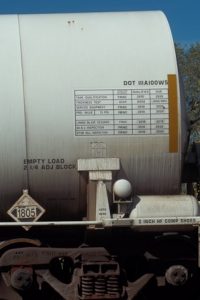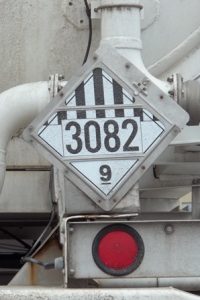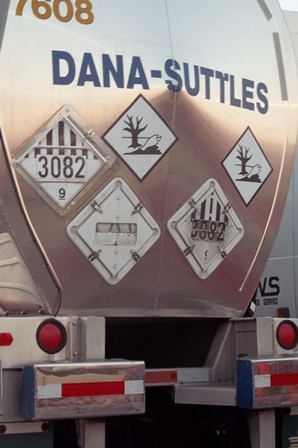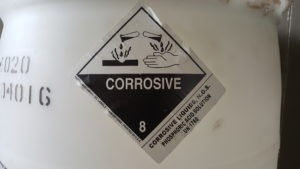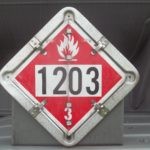Do you have questions about HazMat Employee Training?
…I can help.
If your business or government agency ships, receives, or transports a hazardous material (HazMat) in any amount, then anyone involved in its transportation must receive initial and triennial HazMat Employee Training. Whether the transportation of HazMat is your business or its only something you do to stay in business, HazMat Employee training is necessary to comply with the Hazardous Materials Regulations. Read below for more information about the transportation of hazardous materials and your need to provide HazMat Employee training.
Don’t have time? Check out my concise summary of HazMat Employee Training.
Or…
Don’t take my word for it. Read PHMSA/USDOT’s HazMat Transportation Training Requirements brochure.
Why is HazMat Employee training required?
It’s the law!
The transportation of hazardous materials in commerce creates unique risks to people, property, and the environment. For that reason the Pipeline and Hazardous Materials Safety Administration (PHMSA) within the U.S. Department of Transportation (DOT) creates and enforces the Hazardous Materials Regulations (HMR) for the domestic transportation of HazMat by or for a business. One of the requirements of the HMR is that a HazMat Employer provide training for its employees who have a direct affect on the safe transportation of hazardous materials.
Don’t confuse this training with OSHA’s (the Occupational Health and Safety Administration) HAZWOPER training, sometimes referred to as HazMat training.
Who is required to receive HazMat Employee Training?
Quite simply: a HazMat Employee. OK, then. Who – or what – is a HazMat Employee? Defined at 40 CFR 171.8, a HazMat Employee may be a full-time, part time, or temporary employee or they may be self-employed and their job has a direct affect on the safe transportation of hazardous materials. A HazMat Employee job responsibilities may include any of the following:
- Load, unload or handle hazardous materials. This includes the loading and unloading of cargo tanks or rail tank cars.
- Designs, manufactures, fabricates, inspects, marks, maintains, reconditions, repairs, or tests a packaging for HazMat.
- Prepares hazardous materials for transportation. This includes review of the shipping paper, placing labels and marks on the package, and more.
- Is responsible for the safety of transporting HazMat. This can include the direct supervisors of HazMat Employees.
- Operate a vehicle over a public roadway.
- A railroad signalman.
- A railroad maintenance-of-way employee.
A HazMat Employee can be anyone involved in the transport of hazardous materials.
 What must HazMat Employee training include?
What must HazMat Employee training include?
Per 49 CFR 172, subpart H, HazMat Employee training must include the following:
- General awareness / familiarization training: to provide familiarity with the regulations and to enable a HazMat Employee to recognize and identify a hazardous material.
- Function-specific training: to address the regulations – including exceptions and special permits – applicable to the HazMat Employee’s job.
- Safety training: how to recognize and use emergency response information, measures to protect the employee from HazMat on the job, and methods to avoid accidents.
- Security awareness training: required for all HazMat Employees to provide awareness of security risks associated with the HazMat at their job.
- In-depth security training: a higher level of security training required only for limited HazMat Employees of certain facilities.
Read: Five Components of HazMat Employee Training
And…
- Driver training: safe driving practices and other relevant information for the operator of a vehicle on a public roadway. Read: HazMat Employee Training for Drivers.
HazMat Employee training must include a test.
When must I train my HazMat Employees?
New or re-assigned HazMat Employees must be trained within 90 days and be supervised by a trained and knowledgeable HazMat Employee in that time. Existing HazMat Employees must receive full recurrent training triennially (every three years).
The HazMat Employer must maintain a record of training for the length of the HazMat Employee’s employment and for 90 days after employment ends.
How do I ensure my HazMat Employee training meets the requirements of the PHMSA/DOT?
It is the responsibility of the HazMat Employer to ensure their HazMat Employee’s have been trained and tested pursuant to 49 CFR 172.702. There is no certification or experience requirement for the trainer, so it is important to know who your trainer is, the level of their experience, and their knowledge of the HazMat transportation regulations of the DOT. The challenge comes in finding a training provider who can deliver the information HazMat Employees need to know but is able to make it interesting, engaging, and relevant to their job function. Check out my testimonials to see what your peers thought about my training.
Also, discuss the regulations and your training needs with the training provider until you are comfortable that they have the knowledge and the skills necessary. To help you with this I wrote: Eleven Questions to ask your HazMat Employee Training Provider.
Before you contact me , feel free to read the articles I’ve written for my blog. You will quickly see that I am not satisfied with the easy answer but instead dig as deep as necessary to come to an understanding of the Hazardous Materials Regulations.
I have 25+ years experience with the applicable regulations as a truck driver, Hazardous Waste Technician, consultant, and trainer. I have immersed myself in the HazMat transportation regulations and believe I can provide a quality training experience. My resume.
Where can I get more information about the Hazardous Materials Regulations of PHMSA/DOT and HazMat Employee Training?
There’s a lot of good information on the PHMSA website.
- HazMat Transportation Training Requirements
- USDOT Chart 16 – Hazardous Materials Markings, Labeling and Placarding Guide
- How to use the Hazardous Materials Regulations
Or, you may subscribe to my blog or follow me on any one of a variety of social media.
Frequently asked questions about the transportation of hazardous materials:
1. Where is the regulatory citation that requires HazMat Employee training?
2. What is the intent of HazMat Employee training?
3. Who – or what – is a HazMat Employee?
4. Who – or what – is a HazMat Employer?
5. What is a hazardous material?
6. What is meant by “…causes hazardous materials to be transported”?
7. What is meant by “…in commerce”?
8. How often is HazMat Employee training required?
9. What must HazMat Employee training include?
10. Who is responsible to ensure that all HazMat Employees receive training?
11. Who can complete the training of HazMat Employees?
12. What topics are covered in the HazMat Employee training provided by Daniels Training Services?
13. Does ICAO/IATA and IMO training fulfill the HazMat Employee training requirements?
14. Does training required by OSHA and/or EPA fulfill the HazMat Employee training requirement?
16. Who – or what – is the carrier for HazMat?
17. Who – or what – is the shipper for HazMat?
18. What is a large bulk quantity?
20. Does Daniels Training Services provide HazMat Employee training for drivers?
22. May HazMat Employers/Employees train and test themselves (e.g. an owner/operator)?
25. Must HazMat Employee training include a test?
1. Where is the regulatory citation that requires HazMat Employee training? Title 49 of the Code of Federal Regulations part 172, subpart H (49 CFR 172, subpart H) contains a description of the the type and frequency of training a HazMat Employer required to provide to its HazMat Employees. For more information refer to this PHMSA/USDOT publication: HazMat Transportation Training Requirements.
2. What is the intent of HazMat Employee training? The intent of HazMat Employee training is to reduce the potential for hazardous material incidents occurring in transportation which might threaten human health or the environment. PHMSA/USDOT determined that the existence of the Hazardous Materials Regulations (49 CFR 100-185) was not enough. So in in 1990, as part of a package of rules known as HM 126F, it created the Federal regulations that require a HazMat Employee to ensure its HazMat Employees are tested and trained per the requirements of 49 CFR 172.704.
3. Who – or what – is a HazMat Employee? A HazMat Employee is defined at 49 CFR 171.8 as someone employed by a HazMat Employer who in the course of employment directly affects hazardous material transportation safety. This includes a person who loads or unloads hazardous materials from vehicles (including bulk transfer), transports hazardous materials over public roadways, prepares, reviews or signs shipping papers for hazardous material shipments, and those with direct management oversight of the above. A HazMat Employee is a person whose job function affects the design, creation, or marking of a HazMat packagin. A HazMat Employee also includes a railroad signalman or a railroad maintenance-of-way employee.
4. Who – or what – is a HazMat Employer? A HazMat Employer is defined at 49 CFR 171.8 as a person who is self-employed or who employs or uses at least one HazMat Employee on a full-time, part time, or temporary basis and who transports or causes hazardous materials to be transported in commerce or is involved in the design, manufacture, or reconditioning of hazardous material packaging. It includes all departments, agencies and instrumentalities of Federal and state governments. Not all transportation of HazMat by a government agency is subject to regulation; read: The Government Employee Exemption.
5. What is a hazardous material? A hazardous material is defined at 49 CFR 171.8 as a substance or article capable of posing an unreasonable risk to health, safety, or property when transported in commerce. A hazardous material may be anyone of the following:
- Identified by name in the Hazardous Materials Table at 49 CFR 172.101.
- Meets the definition of at least one hazard class or division of the PHMSA/USDOT.
- A reportable quantity (RQ)of a hazardous substance.
- A hazardous waste subject to full regulation of the U.S. Environmental Protection Agency (USEPA).
- A marine pollutant.
- An elevated temperature substance.
6. What is meant by “…causes hazardous materials to be transported”? This includes a wide range of business activities that result in the transportation in commerce of a hazardous material. For example: a person orders a paint (Class 3 Flammable Liquid) to be delivered to its property for use in making its product. That act causes a hazardous material to be transported. Another example: a person generates a waste and arranges for its off-site transportation. That also causes a hazardous material to be transported. And another, a person delivers itself, or has a third party deliver, a drain cleaner (Class 8 Corrosive Material) to a customer. Again, this causes a hazardous material to be transported. Read: What is a “Person” in the Regulations of PHMSA/USDOT and USEPA?
7. What is meant by “…in commerce”? Short answer: anything that is done by or for a business. Your personal trips to the hardware store and home are not considered to be in commerce. Those same trips done by or for a business are considered to be in commerce.
8. How often is HazMat Employee training required? Initial training of a HazMat Employee is required within 90 days of employment or change in job duties. Full recurrent training (not just a review of initial training) is required every three years. Re-training is also required if the regulations applicable to a HazMat Employee have changed. Annual training is a good way to stay informed of the constantly changing HazMat regulations. In-Depth Security Training must be provided every three years or within 90 days whenever the Security Plan is updated.
9. What must HazMat Employee training include? HazMat Employee training must include the following:
- General awareness/familiarization training.
- Function-specific training.
- Safety training, including:
- Emergency response information required by subpart G of part 172;
- Measures to protect the employee from the hazards associated with hazardous materials to which they may be exposed in the work place, including specific measures the hazmat employer has implemented to protect employees from exposure; and,
- Methods and procedures for avoiding accidents, such as the proper procedures for handling packages containing hazardous materials.
- Security awareness training.
- In-depth security training (if applicable).
10. Who is responsible to ensure that all HazMat Employees are trained and tested? Pursuant to 49 CFR 172.702, the HazMat Employer is responsible for ensuring that each of its HazMat Employees is trained and tested in accordance with the regulations. While final responsibility remains with the employer, Daniels Training Services provides you with all the necessary documentation to ensure compliance with this regulation.
11. Who can complete HazMat Employee training? Training may be provided by the HazMat Employer or other public or private sources. It is not required to be completed by a ‘certified’ instructor. However, it is of great value to have an experienced instructor who can answer questions and provide guidance.
12. What topics are covered in the HazMat Employee training provided by Daniels Training Services? My training will meet the regulatory requirements of PHMSA/USDOT for HazMat Employees initial and triennial training requirements of 49 CFR 172, subpart H. But that doesn’t really tell you much. My training content will vary depending on the needs of the customer and the function specific responsibilities of their HazMat Employees. However, whether my Onsite Training, a Webinar, or some other training format, HazMat Employee training by Daniels Training Services will include the following to some degree:
- Introduction to the regulatory agencies and to PHMSA/USDOT.
- Introduction to the Hazardous Materials Regulations.
- HazMat Employee training requirements.
- Registration as shipper or carrier of HazMat.
- Classification of a hazardous material
- Forbidden HazMat
- Symbols of column 1 in the Hazardous Materials Table
- Types of packaging
- Bulk v. non-bulk
- General packing requirements
- Authorized packaging
- Special provisions of column 7 in the Hazardous Materials Table
- Specification packaging (UN Standard).
- Packaging closure
- Packaging exceptions
- Hazard communication
- HazMat labels
- Package marks
- Shipping papers
- Placards
- Emergency information
- HazMat securement and segregation
- More exceptions to Hazardous Materials Regulations
- Safety and emergency response
- Use of the emergency response guidebook
- General awareness security training
- Safety and security plan
- In-depth security training
- Prepare for PHMSA/USDOT inspections
13. Does ICAO/IATA and IMO training fulfill the HazMat Employee training requirements? Not entirely, no. The International Civil Aviation Organization (ICAO) Technical Instructions (though more likely the International Air Transport Association (IATA)) and the International Maritime Organization (IMO) require training for personnel involved in the transport of dangerous goods by air or vessel, respectively. If conducted per the requirements of the international regulations, this training may meet the requirement to provide function-specific training only. It does not meet the remaining HazMat Employee training requirements (i.e. general awareness/familiarization, safety and emergency response, security awareness, and in-depth security.
14. Does training required by OSHA and/or EPA fulfill the Hazmat Employee training requirements? Not entirely, no. While it is possible that employee training provided to comply with the regulations of the EPA or OSHA may fulfill some requirements of HazMat Employee training, e.g. security awareness or emergency response; it is not likely it will address all of the regulatory requirements to train and test HazMat Employees. It is the responsibility of the HazMat Employer to ensure HazMat Employees have been trained and tested to meet the requirements of 49 CFR 172, subpart H.
15. What is PHMSA? The Pipeline and Hazardous Material Safety Administration (PHMSA) is one of many administrations within the U.S. Department of Transportation (DOT). PHMSA is responsible for ensuring the safe and secure movement of hazardous materials by all modes of transportation: highway, rail, vessel, aircraft. It therefore has overlapping authority with other administrations and bureaus within the DOT such as: Federal Aviation Administration (FAA), Federal Railroad Administration (FRA), Federal Motor Carrier Safety Administration (FMCSA), and others. Its authority may also overlap with the US Coast Guard. Note: while the Coast Guard is no longer a part of the DOT, it operates under a memorandum of understanding to enforce DOT regulations for transportation by vessel.
16. Who – or what – is the carrier for HazMat? As defined at 49 CFR 171.8, a carrier means a person who transports passengers or property in commerce by rail car, aircraft, motor vehicle, or vessel. The definition is not limited to the transportation of hazardous materials. A carrier may transport either hazardous or non-hazardous materials or both.
17. Who – or what – is the shipper for HazMat? Interestingly, the term “shipper” is not defined at 49 CFR 171.8 despite the fact that it is used throughout the Hazardous Materials Regulations. 49 CFR 171.8 defines a Person who Offers or Offeror as:
(1) Any person who does either or both of the following:
(i) Performs, or is responsible for performing, any pre-transportation function required under this subchapter for transportation of the hazardous material in commerce.
(ii) Tenders or makes the hazardous material available to a carrier for transportation in commerce.
(2) A carrier is not an offeror when it performs a function required by this subchapter as a condition of acceptance of a hazardous material for transportation in commerce (e.g., reviewing shipping papers, examining packages to ensure that they are in conformance with this subchapter, or preparing shipping documentation for its own use) or when it transfers a hazardous material to another carrier for continued transportation in commerce without performing a pre-transportation function.
A PHMSA letter of interpretation (05-0188) clarifies the relationship between offeror and shipper as: “When the word ‘shipper’ is used, such as in the title of Part 173 – ‘Shippers-General Requirements for Shipments and Packagings’ – that word refers to a person who prepares a shipment for transportation.” This interpretation directs us back to the definition of an offeror found in 49 CFR 171.8. Read: Who is the “Shipper” for the Transport of Hazardous Materials?
18. What is a large bulk quantity? As used in 49 CFR 172.800(b), “large bulk quantity” refers to a quantity greater than 3,000 kg (6,614 pounds) for solids or 3,000 liters (792 gallons) for liquids and gases in a single packaging such as a cargo tank motor vehicle, portable tank, tank car, or other bulk container.
19. What is a bulk packaging? 49 CFR 171.8 defines a bulk packaging as a packaging, other than a vessel or a barge, including a transport vehicle or freight container, in which hazardous materials are loaded with no intermediate form of containment. A Large Packaging in which hazardous materials are loaded with an intermediate form of containment, such as one or more articles or inner packagings, is also a bulk packaging. Additionally, a bulk packaging has: (1) A maximum capacity greater than 450 L (119 gallons) as a receptacle for a liquid; (2) A maximum net mass greater than 400 kg (882 pounds) and a maximum capacity greater than 450 L (119 gallons) as a receptacle for a solid; or (3) A water capacity greater than 454 kg (1,000 pounds) as a receptacle for a gas as defined in §173.115 of this subchapter. Read: Bulk Packaging for HazMat Explained!
20. Does Daniels Training Services provide HazMat Employee training for drivers? Yes. HazMat Employee training is required for anyone involved in the transportation of a hazardous material. This includes the drivers of a motor vehicle that transports any amount of HazMat over a public roadway for any distance – unless subject to the Materials of Trade exception. Driver training must include the applicable regulations of the Federal Motor Carrier Safety administration (FMCSA) and specific safe driving practices. Training may also need to address the special needs for those who transport HazMat in bulk quantities of more than 1,000 gallons. At the discretion of the employer, the requirements for driver training may be met by the maintenance of a Commercial Driver’s License (CDL) with the applicable endorsements. Read: HazMat Employee Training for Drivers.
21. Must I provide modal-specific training if I offer for transport (shipper) or transport (carrier) HazMat by highway, rail, vessel, or air? As a shipper of HazMat you must provide training for all HazMat Employees that includes their function-specific responsibilities. A shipper is not, however, required to provide modal-specific training for the regulations applicable to a carrier. For example, if you offer for transport HazMat by highway your HazMat Employee training must include the applicable shipper responsibilities of 49 CFR part 173 but will likely not include the regulations of 49 CFR 177 since those are mostly applicable to the motor carrier and driver. As a carrier of HazMat your HazMat Employee training must include the modal-specific responsibilities. Read: Modal-Specific Training Requirements of the HMR.
22. May HazMat Employers/Employees train and test themselves (e.g. an owner/operator)? Yes. Self-training is acceptable provided that all of the training requirements are met.
23. Who certifies that an instructor of HazMat Employee training is qualified to train, test, and certify as required per 49 CFR 172.704? PHMSA/USDOT does not review, approve, or certify training programs. The HazMat Employer must determine if the trainer has the qualifications and skills necessary to deliver the information to its employees.
24. Does the trainer who teaches and tests the HazMat Employee certify that the HazMat Employee is trained and tested? No. It is not the responsibility of the trainer to ensure that a HazMat Employee is properly trained and tested. That is the responsibility of he HazMat Employer. However, the HazMat Employer may designate and outside source to train, test, and certify on his/her behalf that the employee has been trained and tested.
25. Must HazMat Employee training include a test? Yes. HazMat Employee training must include a test in order to meet the requirements of the HMR. Pursuant to 49 CFR 172.702(d), it is the responsibility of the HazMat Employer to ensure each HazMat Employee is trained and tested.
